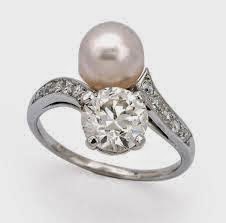Denmark Pearl Diamond Fashion Jewelry.
By Aamir Mannan.
.jpg)
In the webpage dealing with the "History of the Discovery and Appreciation of Pearls - the Organic Gem Perfected by Nature - Page 1" it was shown without any ambiguity that pearls were first discovered and came to be appreciated in the East or the Orient. Several lines of evidence, both historical and archaeological were presented that consolidated this view, the most significant among which was the fact that historically the most ancient sources of pearls in the world, such as the Persian Gulf, the Red Sea and the Gulf of Mannar, were the same regions where some of the earliest human civilizations began, such as the ancient Sumerian
.jpg)
civilization of Mesopotamia, "the cradle of human civilization" and the ancient Egyptian civilization. It appears that the discovery and appreciation of pearls went hand-in-hand with the development of ancient human civilizations. The oldest pearls identified in the Persian Gulf region, a single pierced-pearl and mother-of-pearl artifacts comes from As-Sabiyah, Kuwait, dating back to the late stone age, 6,000-5,000 B.C.E. (7,000-8,000 B.P.). Another solitary pearl belonging to the same period was found among human remains at a site in Umm al-Quwain. A third single pierced-pearl near a female
.jpg)
chin and mother-of-pearl pendants dating back to 5,200-4,200 B.C.E. (7,200-6,200 B.P.) was recovered from a site in Jebel al-Buhais, in Sharjah. Other ancient pearls ranging in age from 4,000-1,000 B.C.E. (6,000-3,000 B.P.) were also discovered from sites in Oman, Iraq, Bahrain, Iran, Kuwait and Palestine. These areas where the discoveries were made were part of the ancient Sumerian (5,900-2,350 B.C.), Akkadian (2,350-2,193 B.C.), Babylonian (2,100-1,600 B.C.) or Assyrian empires (2,000-1,800 B.C.). and the age of the pearl or pearl jewelry discovered roughly coincide with the period of these ancient civilizations. Burial of people with a pierced pearl in their right hands appear to be a common custom prevalent during these ancient periods. Thus, without any doubt the Persian Gulf region, appears to be one of
.jpg)
the regions where pearls were first discovered and came to be appreciated. This webpage is dedicated to the history of how the knowledge of the appreciation of pearls initially spread from the Persian Gulf to the countries of the west such as Greece and Rome, where such appreciation reached unprecedented levels, and subsequently spread to other nations in Europe in mediaeval times, where the use of pearls became closely identified with the monarchies, and to cater to the increase in demand for pearls, apart from the traditional sources of the Persian Gulf, the Red Sea and the Gulf of Mannar, new sources of pearls were discovered by Columbus in America in 1498, which were then thoroughly exploited
.jpg)
by the Spanish. The esteem with which pearls were held, by the monarchies, the rich and the well-to-do, made them the most valuable and sought after commodity since the beginning of the Christian era, and was considered more valuable than gold, a status quo that prevailed into modern times, with Cartier purchasing its multistoried headquarters in New York in 1916 for the value of just a single two-strand pearl necklace valued at $1.2 million.
.jpg)
.jpg)
.jpg)
.jpg)
.jpg)
.jpg)
.jpg)
.jpg)
.jpg)
.jpg)
0 comments:
Post a Comment